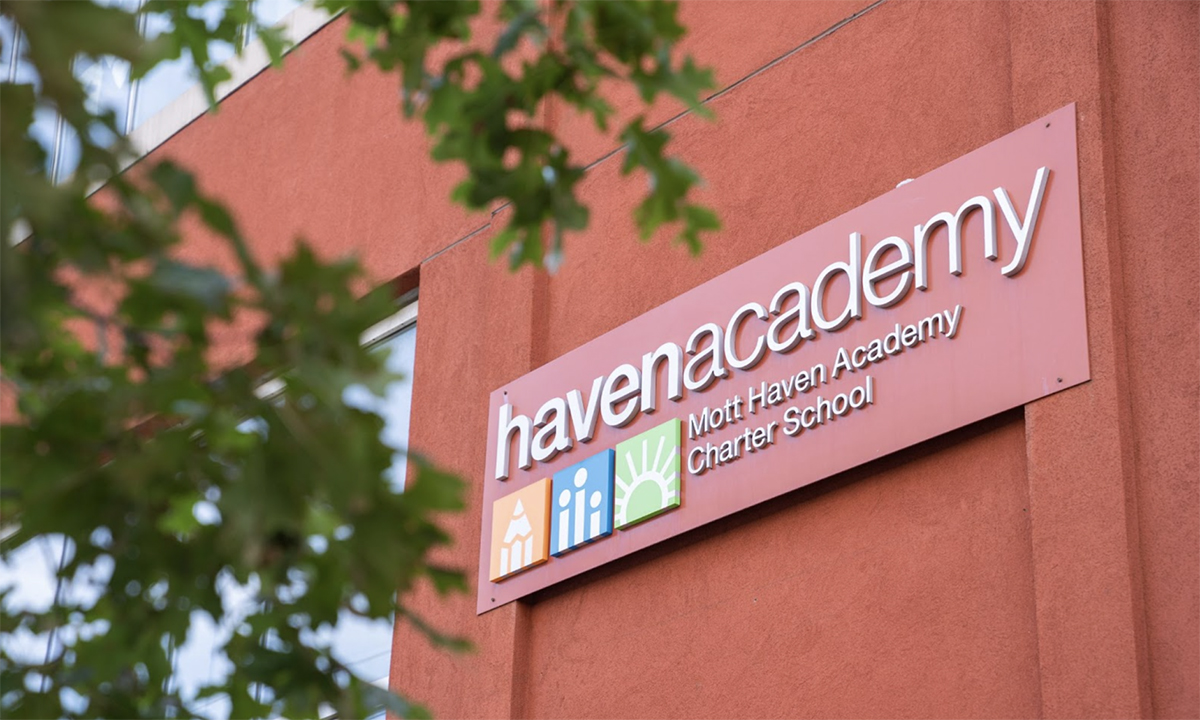Educating Kids in Foster Care: Lessons Learned from a Unique School in the Bronx
Nauiokas & Hartzog: Mott Haven Academy Charter School has robust staffing, social services, structure — & the flexibility to cater to students’ needs

Get stories like this delivered straight to your inbox. Sign up for The 74 Newsletter
For decades, school systems have focused on what child welfare-involved students can’t do, instead of reimagining what support schools can provide for them. In New York City, fewer than 20% of kids in the child welfare system graduate high school. These students experience chronic absenteeism, and their test scores are far below average. These failures have nothing to do with the kids and everything to do with a system that has been unwilling or unable to educate them.
This is what inspired the creation of Mott Haven Charter School Academy over 14 years ago. The school’s founders and their partners at The New York Foundling, one of New York’s oldest and largest social services providers, asked some essential questions: What can we achieve together for students in the child welfare system? What kind of outcomes could a school specifically designed for students in foster care, and those experiencing poverty, produce?
Those outcomes are pretty incredible.
By design, Haven Academy serves a highly vulnerable student population. Roughly half are in the child welfare system or receive services preventing entry into foster care. The other half come from a local school district that is in one of the poorest congressional districts in the country. One key aspect of the school’s model is that students are considered part of the child welfare group if they have ever been involved with that system. This speaks to the school’s belief that the trauma and disruptions to a child’s life induced by the child welfare system are long-lasting and should be treated as such.
Disruption is an important variable for these students. Many face housing insecurity and homelessness. They repeatedly move homes, move schools, change counselors and have to start over, falling further and further behind. As a result, very few students who have been in foster care are able to enroll in college, and of those who do, less than 5% graduate.
Haven Academy addresses these challenges through three core tactics: enforcing a strong school culture, maintaining robust staffing and providing social services in partnership with The Foundling, such as family counseling, health care and dedicated caseworkers alongside the academic programming. In short, educators and caregivers at Haven prioritize social-emotional well-being alongside academic success. To serve this very unique student population, you cannot have one without the other.
Haven Academy’s school culture creates an environment that balances predictability and structure with enough flexibility to cater to each student’s needs. When a child’s entire life outside of school feels unpredictable and out of control, that student needs a sense of stability at school. All of Haven’s teachers maintain the same set of expectations for students, which are regularly repeated verbally to students in each classroom. In every area of the school, common expectations are posted on the walls and taught by the teachers. When a child acts out, the response to that behavior reflects the previously communicated expectations. These expectations never change. This creates the most predictable environment many students have in their lives.
For example, a child facing a behavioral challenge is never removed from the classroom or the school. Instead of suspension or expulsion, students are immediately offered solutions to help them manage their emotions. This might mean a comfortable chair as opposed to a traditional desk chair; sitting at a separate desk rather than at a table with other students; or a cozy corner with books, art supplies and other activities that can help de-escalate big emotions. School must be a place where students are always welcome, no matter what happens inside the classroom or out.
Haven Academy’s staffing model requires two teachers in every general-education classroom. This increases the investment per classroom and strikes a critical balance between structure and flexibility. If a child needs individualized attention, one teacher can provide it while the other continues with the lesson plan. This creates a sense of consistency and minimizes distractions for the rest of the class. All Haven teachers are also trained to create individualized plans for students as needed. This allows all educators to teach to the student, not the state standards.
Haven also provides wraparound services, in partnership with The New York Foundling. While the average student to social worker ratio in District 7, where Haven is located, is 371:1, at Haven, it’s 24:1. Haven students also have access to a robust tutoring program that provides academic and life skills support outside the classroom.
The positive outcomes that have resulted from this unique model are undeniable. On state English and math tests, Haven students outperform their peers in the school district, city and state. This is true for both students who are involved in the child welfare system and those who are not. For example, 51% of students at Haven were ranked proficient in math, based on state test scores for the 2018-19 school year. This is compared with 46% of students in New York City, 47% statewide and just 26% of students in District 7.
Chronic absenteeism is 16 percentage points lower than the citywide average for kids in foster care. During the 2018-19 school year, 28% of Haven prevention students and 20% of students in foster care were chronically absent. This represented a marked improvement from earlier years for children in prevention services, who have historically struggled most with attendance among Haven students. In the same comparison year, 36.9% of elementary and middle school students in foster care citywide were chronically absent. The long-term impact of this last piece is unquantifiable, but it stretches far beyond the classroom, and beyond the Haven campus.
There are tens of thousands of children in New York City and many hundreds of thousands nationally who have been involved with the child welfare system. Homelessness and other factors that have historically made it difficult for children to learn are becoming more acute. Every family has been affected by the pandemic even three years on, experiencing isolation, disruption and economic impacts. There is an urgent need to support vulnerable student populations like the students at Haven Academy, and Haven’s model is one worth sharing.
Get stories like these delivered straight to your inbox. Sign up for The 74 Newsletter

;)

